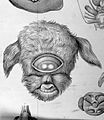Congenital disorder
Medical condition
| Cyclopia |
|---|
| Other names | Cyclocephaly, synophthalmia |
|---|
 |
| Fetuses with cyclopia |
| Specialty | Medical genetics |
|---|
| Usual onset | During embryonic development |
|---|
| Duration | Lifelong |
|---|
| Prognosis | Always fatal within a day |
|---|
| Frequency | 1 in 100,000 births |
|---|
Cyclopia (named after the Greek mythology character cyclopes), also known as alobar holoprosencephaly, is the most extreme form of holoprosencephaly and is a congenital disorder (birth defect) characterized by the failure of the embryonic prosencephalon to properly divide the orbits of the eye into two cavities. Its incidence is 1 in 16,000 in born animals and 1 in 200 in miscarried fetuses.[1][2]
Signs and symptoms
Typically, the nose is either missing or not functional. This deformity (called proboscis) forms above the center eye and is characteristic of a form of cyclopia called rhinencephaly or rhinocephaly.[3] Most such embryos are either naturally miscarried or are stillborn upon delivery.
Although cyclopia is rare, several cyclopic human babies are preserved in medical museums (e.g. The Vrolik Museum, Amsterdam, Trivandrum Medical College).[4]
Some extreme cases of cyclopia have been documented in farm animals (horses, sheep, pigs, and sometimes chickens). In such cases, the nose and mouth fail to form, or the nose grows from the roof of the mouth, obstructing airflow and resulting in suffocation shortly after birth.[5]
Causes
Genetic defects or toxins can misdirect the embryonic forebrain-dividing process.[6] One highly teratogenic alkaloid toxin that can cause cyclopia is cyclopamine or 2-deoxyjervine, found in the plant Veratrum californicum (also known as corn lily or false hellebore). Grazing animals are most likely to ingest this plant and induce cyclopia in offspring. People sometimes accidentally ingest false hellebore while pregnant, thinking it is hellebore, an unrelated plant which does not even resemble false hellebore, being recommended as a "natural" treatment for vomiting, cramps, and poor circulation, three conditions which may be present in the early stages of pregnancy.[7] Cyclopia occurs when certain proteins are inappropriately expressed,[8] causing the brain to stay whole, rather than developing two distinct hemispheres. This leads to the fetus having one optic lobe and one olfactory lobe, resulting in the eye and nose malformations of cyclopia.[9]
The Sonic Hedgehog (SHH) gene regulator is involved in the separation of the single eye field into two bilateral fields.[10]
Although not proven, it is thought that SHH emitted from the prechordal plate suppresses Pax6, which causes the eye field to divide into two. If the SHH gene is mutated, the result is cyclopia, a single eye in the center of the face (Gilbert, 2000).
Cultural significance
The Islamic State of Iraq and the Levant used photos of babies born with cyclopia in its recruitment campaign. ISIL claimed the photos depicted Masih ad-Dajjal, who according to the Hadith, would have only one eye. Mainstream Islamic scholars consider the prophecy as referring to a one-eyed man, not a cyclops.[26] One infant whose image was circulated in 2014 was claimed to be Israeli, but was actually Bolivian and from 2008. The baby girl from India born in 2006 (see notable cases above) also had her image used.[27]























